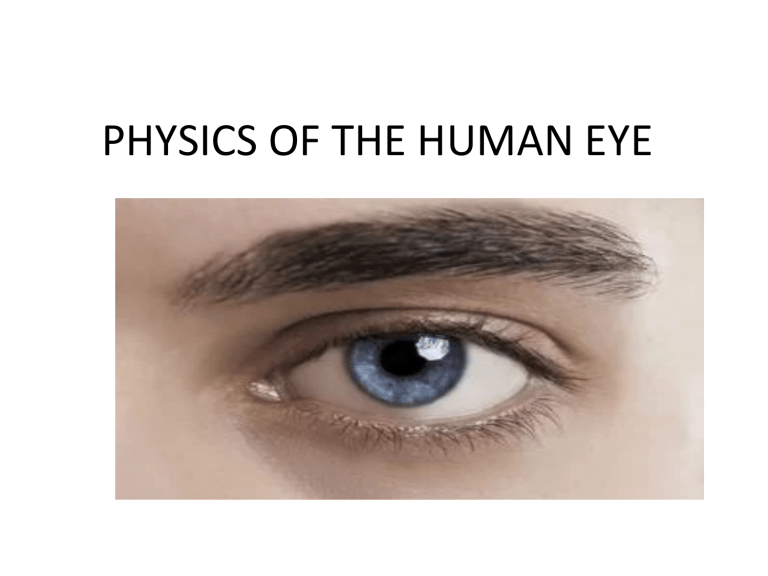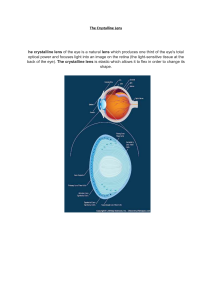
PHYSICS OF THE HUMAN EYE PARTS OF THE EYE HOW THE EYE WORKS • Light enters the eye through the pupil and onto the lens. • The light then passes through the lens and converges and focused unto the retina. • The retina, which is located at the back of the eye acts as screen or film on which the image is produced. REFRACTION OF LIGHT IN THE EYE • When viewing distant objects the lens adjust itself to become flatter. • Less refraction is needed to focus an image unto the retina when viewing far objects. • When viewing near objects the lens adjust itself to become fatter. • More refraction is needed to focus an image unto the retina when viewing near objects. IMPORTANT FEATURES OF THE EYE • ACCOMMODATION – This is ability of the lens to adjust itself to provide better focus of image unto the retina. • SHORT-SIGHTEDNESS (Myopia) – The ability to see objects clearly that are near. Far objects are blurred. • LONG-SIGHTEDNESS (Hyperopia) – The ability to see objects clearly that are far away. Near objects are blurred. • ASTIGMATISM – This is the unevenness or asymmetry in how the eye focus light from objects in different planes. This is due mainly to unevenness in the shape of the cornea but can also be due to irregularities with the lens or retina. • CATERACTS - A cataract is a clouding of the lens in the eye that affects vision. Most cataracts are related to aging. Cataracts are corrected by glasses with converging lens or by removing the lens through surgery. FAR AND NEAR SIGHTEDNESS CORRECTING NEAR-SIGHTEDNESS CORRECTING NEAR-SIGHTEDNESS • A diverging or concave lens is placed in front of the eyes to enable persons to see far objects. • In a near-sighted person the eye lens bends the light too much preventing it from being focused on the retina. • The diverging lens spreads out the light entering the eye thereby reducing the over convergence of the eye lens. CORRECTING FAR-SIGHTEDNESS CORRECTING FAR-SIGHTEDNESS • A converging or convex lens is placed in front of the eyes to enable persons to see near objects. • In a far-sighted person the eye lens does not bends the light enough to focus the image on the retina. • A converging lens bends the light entering the eyes thereby compensating for the under convergence of the eye lens. DEPTH OF FIELD & DEPTH OF FOCUS DEPTH OF FIELD & DEPTH OF FOCUS • Depth of Field – Is the distance in front of the eye between the persons near point and far point where an object can still be seen clearly. • Depth of Focus - Is the distance towards the back of the eye where the image is in focus. IMAGE FORMATION IN SIMPLE CAMERA • Camera: Image is real, diminished & inverted. IMAGE FORMATION IN MAGNIFYING GLASS • Magnifying glass POWER OF A LENS • POWER RANGE OF THE EYE • A person with normal (ideal) vision can see objects clearly at distances ranging from 25 cm to essentially infinity • The eye is most relaxed when viewing distant objects • Vision of very distant objects is called totally relaxed, while close vision is termed accommodated, with the closest vision being fully accommodated. POWER RANGE OF THE EYE • Calculate the power of the eye when viewing objects at the greatest and smallest distances possible with normal vision, assuming a lens-to-retina distance of 2.00 cm (a typical value). • Strategy • For clear vision, the image must be on the retina, and so di = 2.00 cm here. For distant vision, do ≈ ∞, and for close vision, do = 25.0 cm POWER RANGE OF THE EYE POWER RANGE OF THE EYE POWER RANGE OF THE EYE • For an eye with this typical 2.00 cm lens-to-retina distance, the power of the eye ranges from 50.0 D (for distant totally relaxed vision) to 54.0 D (for close fully accommodated vision), which is an 8% increase. Questions • Correcting Nearsightedness What power of spectacle lens is needed to correct the vision of a nearsighted person whose far point is 30.0 cm? Assume the spectacle (corrective) lens is held 1.50 cm away from the eye by eyeglass frames. • Correcting Farsightedness What power of spectacle lens is needed to allow a farsighted person, whose near point is 1.00 m, to see an object clearly that is 25.0 cm away? Assume the spectacle (corrective) lens is held 1.50 cm away from the eye by eyeglass frames. SOLUTION 1 (Myopia) • Strategy • You want this nearsighted person to be able to see very distant objects clearly. That means the spectacle lens must produce an image 30.0 cm from the eye for an object very far away. An image 30.0 cm from the eye will be 28.5 cm to the left of the spectacle lens (see Figure 2). Therefore, we must get di = −28.5 cm when do ≈ ∞. The image distance is negative, because it is on the same side of the spectacle as the object. • P = - 3.51 D SOLUTION 1 (Hyperopia) • Strategy • When an object is held 25.0 cm from the person’s eyes, the spectacle lens must produce an image 1.00 m away (the near point). An image 1.00 m from the eye will be 98.5 cm to the left of the spectacle lens because the spectacle lens is 1.50 cm from the eye (see Figure 3). Therefore, di=−98.5 cm. The image distance is negative, because it is on the same side of the spectacle as the object. The object is 23.5 cm to the left of the spectacle, so that do=23.5 cm. • P = 3.24 D MORE QUESTIONS • What is the far point of a person whose eyes have a relaxed power of 50.5 D? • What is the near point of a person whose eyes have an accommodated power of 53.5 D? • The far point of a myopic administrator is 50.0 cm. (a) What is the relaxed power of his eyes? (b) If he has the normal 8.00% ability to accommodate, what is the closest object he can see clearly? • A myopic person sees that her contact lens prescription is −4.00 D. What is her far point?





